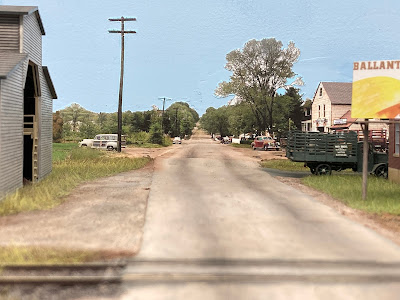For some reason, still unknown to me to this day, I was drawn to the idea of operating a lowly, local way-freight, switching the various industries along a branchline, and interacting with the folks along the way. Longtime readers of The Valley Local will attest to the fact that - almost 40 years later - I'm still enamored of this type of operation and my current layout focuses on the interaction of no less than four local freight jobs.
But check out the silhouette of the train. I didn't know it at the time, but that's an EMD SW-1 on the front. I think this image must've been subconsciously etched on my brain, since I've had a soft spot for EMD end-cab switchers ever since.
Like most of us in the hobby, my modeling preferences evolved - sometimes in unanticipated directions - and, after flirting with freelancing, and a serious infatuation with the Rutland (once Atlas came out with its excellent RS-3 model), I settled hard into modeling my "local" railroad - The New York New Haven & Hartford - and the era that most excited me was the late 1940s - right at the height of the NH's steam/diesel transition.
While the New Haven bought its first end-cab switchers in the 1930s, and had dozens of them by the late 40s, they were all Alco products. The railroad didn't get an EMD end-cab switcher until their fleet of SW-1200s (class DEY-7) in 1956 and, as cool as the SW-1200 looks (even cooler than the ubiquitous Alco S-1s and S-2s, IMO), it's not an SW-1. And it's way past my chosen era (though I did end up getting one, just for kicks). The SW-1 was first produced in the late 1930s.
Hmmmmmm.....
Why B&M #1109?
Seeing an actual prototype SW-1, up close and personal, fired my imagination just like it had almost 4 decades earlier. And since it was a Boston & Maine engine, at least it was close in proximity to the New Haven. . .
I later remembered that the RMNE, way back in 1986 when it was the Connecticut Valley Railroad Museum (CVRM), had purchased the 1109 from the Pioneer Valley RR. The PVRR had acquired it in 1982 from the Montpelier & Barre (coincidentally, right before I entered the hobby) who'd bought it from the B&M in 1959. Having been built in November 1939 as the first unit of the B&M's first batch of SW-1s, the 1109 is actually pretty notable as the first diesel to have EMD's famous 567 prime mover and is currently the oldest diesel locomotive still in existence that was used by a New England railroad.
That, along with my affinity for the SW-1, might be enough to model it. But there's more(!)
It turns out, the 1109 is the only SW-1 to have ever turned a wheel on the Valley Line!
I'd totally forgotten not only that the CVRM had purchased the 1109 and stored it at the Valley RR in Essex, CT for years, but it had also been stored in the yard at Bokum Road in Old Saybrook. In fact, it was literally 1/4 mile away from my house for the first 8 months we lived here and actually rolled past my backyard when it was towed away to its new home in Thomaston.
Yeah - I either wasn't aware of, or had totally forgotten, all of that.
So, when I saw the 1109 last fall, the brain matter started kicking in - I had to model it! Thankfully for my prototype sensibilities, the New Haven and the B&M often leased power from each other. And - while I have no direct evidence (yet) of the New Haven leasing an SW-1, much less evidence of one actually operating on the Valley or Airline, I think an HO scale version of the 1109 can be at least plausibly used on my layout.
At least that's my story and I'm sticking to it :^)
Modeling
Pete will remember all during that trip that I was on the lookout for an SW-1 model in HO scale. A quick internet search showed that Walthers had done one back in the 90s, but I'm kind of glad I missed out since I also read that that first run wasn't very good. Toward the end of our trip, I actually found an undec at Hobby World in North Adams, MA - but it was from that first run, so I passed.
After the holidays and a busy legislative session, I started looking again - even going so far as to mention it on the Valley Local Facebook page. While I preferred an undec, friend Lou P found a Norfolk Southern one at Tom's Trains in Wethersfield. But Philip Taylor came to the ultimate rescue when he offered to donate a PRR version to the cause. Bonus: it's the later run (Walthers Mainline).
 |
| Northbound arriving in Somerset |
 |
| Along the Airline |
 |
| Arriving in Mill Hollow |










































.JPG)
.JPG)



